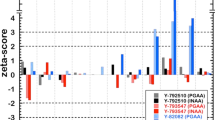Abstract
Instrumental neutron activation analysis (INAA), inductively coupled plasma atomic emission spectrometry (ICP-AES) and ICP mass spectrometry (ICP-MS) (hereafter, ICPs) were applied to meteorite samples for the determination of elemental content. The analytical applicability and suitability of the three methods have been compared. Those comparisons led to the refinement of our analytical procedures for INAA and ICPs, yielding more reliable data. Our INAA data proved to be reliable enough for classifying meteorites, while the ICPs, especially ICP-MS, can characterize elemental abundance features in detail, as demonstrated by REE abundance patterns for the Allende meteorite. In this manner, INAA and ICPs can be used in a complementary fashion in cosmochemical studies.




Similar content being viewed by others
References
Jarosewich E, Clarke RS Jr, Barrows JN (1987) The Allende meteorite reference sample. Smithson Contrib Earth Sci 27:1–49
Bennett J, Grave P, Stopic A (2012) Establishing a basis for nuclear archaeometry in Australia using the 20 MW OPAL research reactor. J Radioanal Nucl Chem 291:13–17
Aso K, Ebihara M (2013) Precise determination of trace amounts of phosphorus in geological samples by inductively coupled plasma atomic emission spectrometry with ion-exchange separation. Anal Chim Acta 779:8–13
Shirai N, Toktaganov M, Takahashi H, Yokotsuka Y, Sekimoto S, Ebihara M (2015) Multielemental analysis of Korean geological reference samples by INAA, ICP-AES and ICP-MS. J Radioanal Nucl Chem 303:1367–1374
Vu CD, Sucgang R, Tran T, Ho D, Shirai N, Ebihara M (2017) Measurements of REE and other elements mass fractions in environmental reference materials (NIST SRM 1646a, NIST SRM 1400, IAEA-359 and IAEA-450) by INAA, ICP-AES and ICP-MS. Geostand Geoanal Res 41:303–315
Ebihara M, Ozaki H, Kato F, Nakahara H (1997) Determination of chlorine, bromine and iodine in rock samples by radiochemical neutron activation analysis. J Radioanal Nucl Chem 216:107–112
Ozaki H, Ebihara M (2007) Determination of trace halogens in rock samples by radiochemical neutron activation analysis coupled with ko-standardization method. Anal Chim Acta 583:384–391
Nakamoto T, Oura Y, Ebihara M (2007) Comparative study of activation analyses for the determination of trace halogens in geological and cosmochemical samples. Anal Sci 23:1113–1119
Kallemeyn GW, Wasson JT (1981) The compositional classification of chondrites—I. The carbonaceous chondrite groups. Geochim Cosmochim Acta 45:1217–1230
Kallemeyn GW, Rubin AE, Wang D, Wasson JT (1989) Ordinary chondrites: bulk compositions, classification, lithophile-element fractionations and composition-petrographic type relationships. Geochim Cosmochim Acta 53:2747–2767
Barrat JA, Zanda B, Moynier F, Bollinger C, Liorzou C, Bayon G (2012) Geochemistry of CI chondrites: major and trace elements, and Cu and Zn Isotopes. Geochim Cosmochim Acta 83:79–92
Anders W, Grevesse N (1989) Abundances of the elements: meteoritic and solar. Geochim Cosmochim Acta 53:197–214
Shinotsuka K, Hidaka H, Ebihara M (1995) Detailed abundances of rare earth elements, Th and U in chondritic meteorites: an ICS-MS study. Meteoritics 30:694–699
Shinotsuka K, Ebihara M (1997) Precise determination of rare earths, thorium and uranium in chondritic meteorites by ICP-MS—a comparative study with RNAA. Anal Chim Acta 338:237–246
Khan R, Shirai N, Ebihara M (2015) Chemical characteristic of R chondrites in the light of P, REEs, Th and U abundances. Earth Planet Sci Lett 422:18–27
Shirai N, Okamoto C, Yamaguchi A, Ebihara M (2016) Siderophile elements in brecciated HED meteorites and the nature of projectile materials in HED meteorites. Earth Planet Sci Lett 437:57–65
Clarke RS Jr, Jarosewich E, Mason B, Nelen J, Gomez M, Hyde JR (1971) The Allende, Mexico, meteorite shower. Smithson Contrib Earth Sci 5:1–53
Akhter R, Shirai N, Ebihara M (2016) Chemical characterization of a chromitite reference sample GPt-5 using INAA and ICP-MS. Geochem J 50:179–185
Ebihara M, Sekimoto S, Shirai N, Hamajima Y, Yamamoto M, Kumagai K, Oura Y, Ireland TR, Kitajima F, Nagao K, Nakamura T, Naraoka H, Noguchi T, Okazaki R, Tsuchiyama A, Uesugi M, Yurimoto H, Zorensky ME, Abe M, Fujimura A, Mukai T, Yada Y (2011) Neutron activation analysis of a particle returned from asteroid Itokawa. Science 333:1119–1121
Ebihara M, Shirai N, Sekimoto S, Nakamura T, Tsuchiyama A, Matsuno J, Matsumoto T, Tanaka M, Abe M, Fujimura A, Ishibashi Y, Karouji Y, Mukai T, Okada T, Uesugi M, Yada T (2015) Chemical and mineralogical compositions of two grains recovered from an asteroid Itokawa. Meteor Planet Sci 50:243–254
Acknowledgements
The Antarctic meteorites used in this study were loaned by the National Institute of Polar Research, Japan, to which our thanks go. This work was financially supported in part by a grant-in-aid defrayed by the Japanese Ministry of Education, Culture, Sports, Science and Technology, MEXT (#25246038 to ME).
Author information
Authors and Affiliations
Corresponding author
Rights and permissions
About this article
Cite this article
Ebihara, M., Shirai, N., Bennett, J.W. et al. A comparison of INAA and ICP-MS/ICP-AES methods for the analysis of meteorite samples. J Radioanal Nucl Chem 318, 1681–1687 (2018). https://doi.org/10.1007/s10967-018-6309-z
Received:
Published:
Issue Date:
DOI: https://doi.org/10.1007/s10967-018-6309-z




